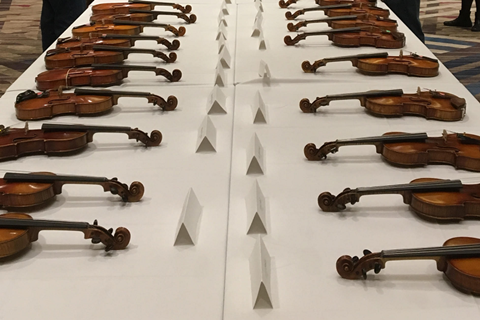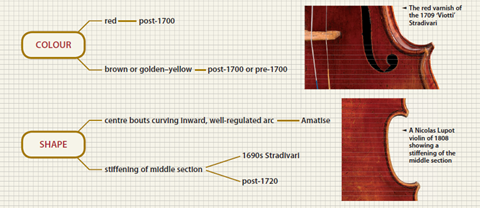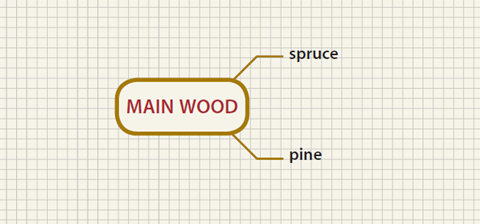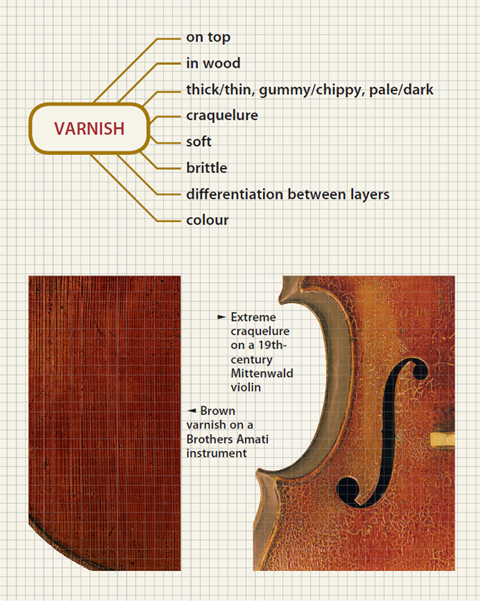Figuring out the maker of an unknown violin takes a trained eye and a detective’s skill, says luthier John Dilworth. Here he gives his personal perspective on the clues and processes of elimination that help experts pinpoint an instrument’s origins. From the July 2010 issue

How we look at violins can be as personal and subjective as how we hear them. For most, the pleasure of looking at a violin is purely that – a pleasure, and an intuitive response to a graceful and symmetrical form. But for some it can be forensically analytical, just as acoustic scientists attempt to put tone into understandable graphs and formulae. Experts, dealers, makers and enthusiasts are all fascinated by the minute differences between one violin and another. So what makes them able to say, with some degree of confidence, who made a particular violin, or have the even greater confidence to say, ‘I don’t know’? Unless they are extremely lucky or preternaturally gifted, they have to work to acquire the skills that permit an understanding of the face of the violin.
For some, a photographic memory enables them to compare an instrument with just about every other one they have seen before. Before the development of photography, this was pretty much the only way that expertise could be gathered. When we look at the records and diaries of historical experts such as Count Cozio, John Betts and the Hill brothers, we see descriptive notes, sketchy diagrams, measurements and ‘code words’ with purely personal resonances. A century ago, the only way to gain a comprehensive knowledge of the various makers was to have a reference collection of actual instruments, as Tarisio and Cozio did. Today we can flit through a whole library of images on a computer file.
You can always look at the label, but that is definitely not to be recommended
When you look at an instrument for the first time, there is a sort of mental checklist, unconscious or deliberate, that usually starts with ‘How old is it?’ It can be astonishing to hear someone state with conviction that an instrument was made ‘between 1760 and 1780’, say. How can you pick a couple of decades out of four centuries? With comparative ease, it turns out, if you have the historical knowledge and a practised eye.
Once the age is established, nationality is usually up next for consideration. Again, a knowledge of the shifting fashions of violin making history is key. Tastes in violin forms – from Amati to Stainer, to Stradivari and Guarneri ‘del Gesù’ – changed at different times in different parts of Europe. Various making styles evolved as particular materials became available in different areas. Once a country is decided, you can move on to the city, and then to a family and at last, by a process of selection and elimination, an individual maker. We hope.
You can always look at the label, of course, but that is definitely not to be recommended. Once you catch a glimpse of a false label, your mind sets off in a particular direction that is always hard to change. And if it’s genuine, it has rather spoilt the fun. Let’s now put ourselves inside the mind of someone with a decent amount of knowledge, examining an unknown violin for the first time. A whole lot of information floods in all at once, and it is important to be able to filter it and deal with it in ‘packets’, using the following areas.
COLOUR & SHAPE

These are our two first impressions and both help us to assess age. If the violin is vaguely red, we can immediately assign it to the post-1700 period (all the following broad statements, I should say, are capable of being revisited and reassessed if the computation breaks down at any point). We know from historical research that red pigments only slowly began to be introduced into violin varnishes after that date. If the violin is basically brown or golden–yellow, it could be earlier than 1700 – or later. We’ll look at other aspects of varnish later. What about the shape? Is it Amatise or Stradivarian? The differences lie mostly in the centre bouts. If these curve inward in a well-regulated arc, the shape qualifies as Amatise. If there is a stiffening of the middle section and a concomitant tightening of the radius in the upper corner, the outline is broadly speaking Stradivarian, and therefore to be dated from about 1690 – if it actually is a Stradivari – or after about 1720, when other makers around the world woke up to the revolutionary change of a couple of seconds of arc in the drawing of those middle bouts. The next most useful area to look at is how the outward arcs of the upper and lower bout meet the corners. Is it a slow reflex curve, almost a straight line, or a sudden swerve?
LENGTH & BREADTH

Shape subdivides into size and proportion. Relative length and breadth is noticeable if you focus in on it, and can be checked with a tape measure, but this is only useful if you know what the standard measurements should be. An Amatise outline can be narrow, belonging to the first generations of the family up until around 1640, or wide – the so-called grand pattern, initiated by Nicolò Amati and copied by most makers thereafter. Oddly, Stradivari’s own early instruments from the 1660s follow the obsolete narrow Amati form, which is very useful to know. Then there is the matter of length. Stradivari’s experiments with the long form are easily identifiable and confined to one decade – the 1690s. But other makers followed that form for years afterwards, and once again, it is a matter of learning who did it and when. A long body length can also indicate 19th-century German work, or much earlier Brescian instruments. Distinguishing any of these candidates from one another leads us to the more complex issues of arching.
ARCHING

The great watershed here is again Stradivari, and that radical period around 1700 when he discovered the flat, full-edged form. These terms are relative, and a simple measurement of the height of the arch is not enough – it’s how the arch progresses from foothills to summit. Amatis can be full in height, but generally have a distinctive and elegant valley around the edge. Brescian archings are usually more like a Zeppelin – minimum surface area, maximum volume. German or Stainer-type archings can be very much like Amati, but the climb from the foothills emerges onto a flat plateau on the summit, rather than a rounded peak.
F-HOLES

Now the brain can sift through the smaller elements of the design. We can look at f-holes analytically, from a historical basis, or purely aesthetically, but the starting point is the distinctive Andrea Amati f-hole with large holes, tiny pointed wings and large, curved nicks. The evolutionary steps involve widening the wings, diminishing the circles and simplifying the nicks until you arrive at Stradivari. Then Guarneri ‘del Gesù’ tears up the rule book. But if you go back to Gaspar da Salò in the previous century, you will see Guarneri’s precedent, entirely unconnected with the Amati template, with small circles, extended wings and a generally broad, open cut.
If you know when these developments took place, you can put a rough date on a violin. But then if you are really keen, you will have a catalogue of different makers’ idiosyncrasies. Some cut the entire f-shape with the knife held vertically. Some did it with the knife held radially to the arch. Some used circle cutters; others used a knife and left chatter marks. Some cut the nicks in two strokes; others didn’t cut right through.
PURFLING & INTERIOR MATERIALS

If you want to go deeper, beyond age and general school of workmanship, all the little characteristics of each maker have to be logged. The materials used are crucial. Once equipped with a supply of purfling, makers tend to stick with it. Ebony for the purfling is rare, and immediately indicates a small handful of possible makers. Likewise whalebone. For the white core, beech is as commonly used as poplar, and it is very important to know by whom, and how to spot it. Then there is boxwood, again helpfully rare, but also holly, maple, and so on and so on.
The interior is similarly very revealing. Once makers are in the habit of using pine offcuts for the blocks and linings, they seldom change. Others chose poplar or willow. Still others used walnut, some adopted mahogany, and some used nothing at all. But this also leads on to structure.
CONSTRUCTION METHODS

Understanding how a violin was made is key to recognising its origin. We generally think of Cremonese instruments as the model for all. But this is not the case. The Cremonese worked in a unique way, and understanding this enables us to recognise their work with relative ease. It’s the less famous makers who are more difficult to identify.
The Cremonese worked from a mould, so outlines are consistent and change in discernible steps with the development of new moulds. Cremonese makers used an internal mould, which necessitated a particular shape of block, and that the linings be mortised into it. If the linings of your violin are mortised into the blocks, it already has a fair chance of being valuable. Your chances increase if the back and table are pinned to the end blocks, because that is how the Cremonese did it. If there is a small peg in the centre of the back, you have probably hit the jackpot. And if there isn’t, it might be a Stradivari anyway, because unlike his colleagues he didn’t seem to like the idea of drilling a hole in the middle of the back. All these things are key elements of Cremonese construction that were not widely imitated until the 19th century.
Yes, I know it’s not that simple. But it all helps in our search for the truth. Sherlock Holmes’s axiom of eliminating the impossible to find the answer works well. If your violin doesn’t have a, b or c, it can’t be a Stradivari. If it has x, y or z, though, it might well be a nice Sebastian Klotz. Understanding the construction is much easier for those with a lot of making experience. An instrument with long corners may well have been made without a mould and blocks at all, so the rib corner joints have to be extended for strength. An instrument that has been made with an exterior mould will be unusually symmetrical. Those originally made with a through neck, without a top block, will probably have some sort of patch fitted in the upper back. Makers tend to pick up on these things.

SCROLL
The scroll presents us with a range of stimuli. We can admire the craftsmanship, we can enjoy the artistic effect, and we can look more deeply for clues that come from the actual design and manufacture. A Cremonese scroll is indeed a thing of wonder. Andrea Amati sat down and designed it with amazing technical virtuosity, foresight and aesthetic sensibility. The apparent geometrical perfection is an illusion brought about by the careful and premeditated application of the chamfer, uniting various angled and curving surfaces, and arriving at an impossibly circular eye. Everything looks round, but isn’t. The pattern he drew served just about every Cremonese maker for the next century and a half, with very minor changes, and seeing any Cremonese scroll is like recognising the members of a large, close-knit family. Again, Guarneri ‘del Gesù’ tried to think outside the box, but he still used the old Amati outline to make the first cuts in the neck block.
Most of the quirks in other scrolls come from the difficulty of laying the chamfer on to the twisting edges of the volute without having a clear idea of how to arrive at the eye. Everyone managed the trick differently, and for many it was obviously a bit of last-minute improvisation. Cutting the chamfer last reduces the outer edges of the flute below the central ridge, giving the whole head a distinctive look. The treatment of the eye and the chamfer alone can speak volumes. Then there are different forms and proportions. Some makers have a slim pegbox and a large volute or vice versa. Some chose to undercut the turns, making them flare out like trumpets. Some tapered them the other way, like flower pots.
WOOD CHOICE

As with the purfling, the main constructional materials can be very revealing. Knowing and being able to spot different species of maple and sycamore, spruce and pine is very helpful. I had great difficulty persuading the wood biologist at Kew Gardens that I could distinguish spruce from pine with the naked eye, but it’s not hard. We just live in different worlds.
Dendrochronology is moving research on tremendously, but reassuringly it tends to confirm most of the traditional attributions of past connoisseurs and experts. Though it can’t tell you who made a violin, it can provide a youngest possible date and offer comparisons with other examples. Fundamentally it has shown that the best wood was shared by many makers throughout Europe and bought from the same source, much like today.
VARNISH

Violin makers who spend years trying to make varnish tend to acquire some sort of familiarity and a largely intuitive response. The difficulty is that so much old varnish is degraded, worn, damaged, polished or retouched, that the first thing you need to do is identify what is original – what lies under the dirt and polish, or more likely, what used to be there once upon a time. Great old violins do have a special luminescence that changes with the fall of light, is impossible to describe, impossible to put into note form, impossible to photograph realistically, and therefore impossible to communicate at all, until you share the experience of looking at it with another devotee.
So ultimately we look for physical, objective clues again – fixed, basic things like colour, differentiation between coats, whether the damage is chipped or rubbed, indicating a brittle or a soft medium, and distinctive things like craquelure which can take many forms. Hard varnish cracks into long, frostlike fissures. Soft varnish pools into little islands, but the patterns are recognisable and consistent for different formulations. Does the varnish lie on top of the wood, or is it absorbed into the wood? Is it thick and gummy, thick and chippy, thin and dark, or thin and pale? Or any combination of the above.
CONCLUSION
Teasing out the general and the specific, the forensic and the intuitive aspects of reading a violin is tricky. You can often get carried away with an immediate impression of an instrument and find that the technical details don’t fit. You then have to think about alternatives or whether the instrument has been radically altered or is an out-and-out fake. In fact the best fun of Sherlockian sleuthing can be had when the evidence contradicts itself – when this purfling doesn’t go with these f-holes or that head, for example. Then you have to examine every little part under a lens and work out what exactly is going on, and where the joins might be.
The older a violin, the easier it usually is to work out what it is. There were fewer makers in the 17th century than there are now, that’s for sure. One of the problems that is sometimes brushed under the carpet is that we are often working from a very small database. With many of the makers discussed, there are actually very few examples that are fully authenticated, and few experts have seen them all. So we don’t actually know the limits of that maker’s style. It can often be a great surprise to meet a very early or very late example of a maker you thought you understood.
The best fun of Sherlockian sleuthing can be had when the evidence contradicts itself
The greatest challenge is to be able to recognise the plethora of work that has been produced since the late 19th century, when national schools and unbroken lines of master and apprentice became disrupted and confused, when earnest copyists began to make academic imitations of valuable instruments, and makers began to experiment more freely and change their style at will. To navigate through most auction rooms you need a good archive of information and a lot of hard facts to guide your intuition. But to enjoy a violin as an expressive piece of sculpture, a historical artefact with a story embedded in its wooden frame and layered varnish, you just need a little imagination as well as a little information.
Even if you simply like to enjoy the beauty of a violin for the pleasure of it, the compulsion to dig deeper and learn more is always strong. And some violins, like some faces, are harder to love. An instrument with unbalanced and ungainly proportions can be disturbing, but sometimes endearing, and all the more so if you can understand why it was made that way.











































No comments yet